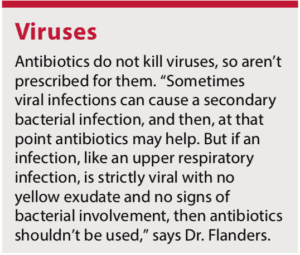If your cat is sick, it is natural to want a medication that will help her feel better. But antibiotics are not a cure-all, and indiscriminate use can cause these drugs to become ineffective.
A Growing Problem
“I’ve certainly seen things get worse over my four decades of veterinary care,” says James Flanders, DVM, board-certified veterinary surgeon and professor emeritus at Cornell University’s College of Veterinary Medicine.
“We have to use more and more powerful antibiotics in order to control infections now. Sometimes the only effective antibiotic is a third or fourth generation drug that has to be given intravenously and has potential side effects if not given carefully under veterinary supervision. In the olden days, a little oral penicillin did the trick!”
When a new drug that is extremely effective is developed, it is tempting to use it for everything. “The problem is that whenever a new antibiotic is developed, it never seems to remain reserved for special, severe infections,” says Dr. Flanders.
Just because a drug can kill a wide range of microbes doesn’t mean that it should be used for every case. Sometimes, it’s like bringing a bazooka to a knife fight. Using a big-gun antimicrobial for every infection means that more bacteria are exposed to it, increasing the chances that some of them will develop resistance. Over time, these resistant bacteria become more prevalent. Eventually, the drug is no longer the miracle that it once was.
 The proper strategy is to use the simplest medication that will be effective and reserve the heavy-duty drugs for infections that require them.
The proper strategy is to use the simplest medication that will be effective and reserve the heavy-duty drugs for infections that require them.
Veterinary Strategies
Antimicrobial resistance is very much on the minds of veterinarians today as they try to preserve the effectiveness of the medications we have. The World Health Organization hosts World Antimicrobial Awareness Week in November to spread the word about antimicrobial resistance and strategies to prevent or slow it. In 2022, the American Veterinary Medical Association launched several resources for veterinarians and pet owners to help understand proper antimicrobial use.
The most important thing that your veterinarian does to help combat antimicrobial resistance is to get an accurate diagnosis before prescribing a medication. This is why your veterinarian requires your cat to come in for an exam and testing when she has a urinary tract infection or upper respiratory infection.
Your veterinarian may recommend sending out samples for a culture and sensitivity test. Once the sample reaches the lab, it will be applied to a culture medium (the ideal condition for bacterial growth) to grow any bacteria that are present. If bacteria do grow, they will then be tested against a variety of antimicrobials to see which drug(s) are effective at neutralizing them (the sensitivity part of this test). This information guides your veterinarian in choosing the best drug to target your cat’s specific infection.
Once the sample reaches the lab, it will be applied to a culture medium (the ideal condition for bacterial growth) to grow any bacteria that are present. If bacteria do grow, they will then be tested against a variety of antimicrobials to see which drug(s) are effective at neutralizing them (the sensitivity part of this test). This information guides your veterinarian in choosing the best drug to target your cat’s specific infection.
While waiting for the culture and sensitivity results, your veterinarian may prescribe a basic broad-spectrum antibiotic to get your cat’s treatment started. If the sensitivity results show that a different medication is necessary, the antibiotic may be changed.
 Your cat likely will not get antibiotics when she has surgery. “There is no need for antibiotics during elective surgeries like castrations or spays that are fairly quick procedures and done with sterile technique,” says Dr. Flanders. “If there is a surgery that will involve the gastrointestinal tract, then perioperative antibiotics are warranted at the time of the surgery.”
Your cat likely will not get antibiotics when she has surgery. “There is no need for antibiotics during elective surgeries like castrations or spays that are fairly quick procedures and done with sterile technique,” says Dr. Flanders. “If there is a surgery that will involve the gastrointestinal tract, then perioperative antibiotics are warranted at the time of the surgery.”




